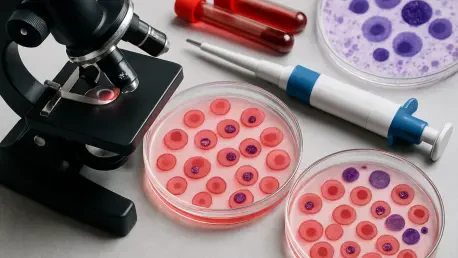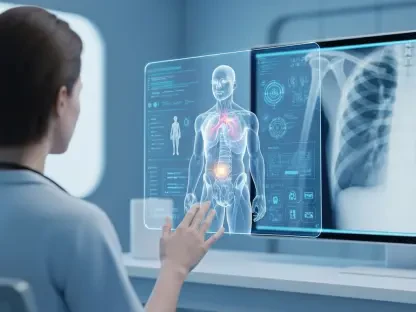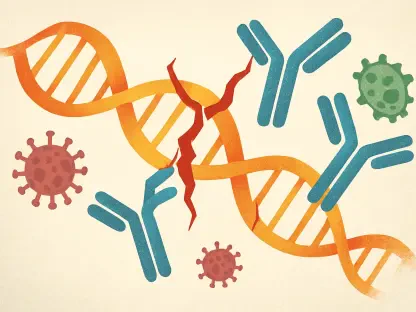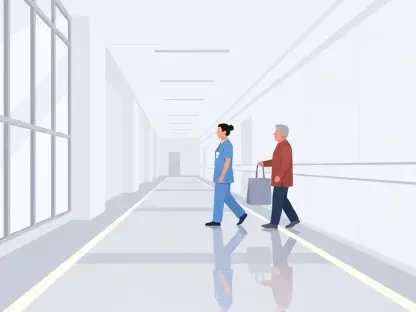Leukemia, a relentless cancer affecting blood-forming cells, has puzzled researchers for decades due to its numerous genetic mutations that somehow result in strikingly similar disease outcomes in patients across diverse cases. A groundbreaking study from Baylor College of Medicine, recently published in the esteemed journal Cell, has unveiled a remarkable finding that could redefine the battle against this illness. Hidden within the nuclei of leukemia cells are tiny structures known as coordinating bodies, or C-bodies, which appear to act as a unifying mechanism behind the disease’s progression, regardless of genetic differences. This discovery shifts the scientific lens from focusing solely on diverse genetic triggers to exploring a shared physical feature that could be targeted for innovative therapies. The implications of this research are profound, promising a potential turning point in how leukemia is understood and treated, and possibly paving the way for broader applications in cancer research.
Unveiling a Hidden Cellular Key
The core of this transformative research lies in the identification of C-bodies, microscopic compartments within the nuclei of leukemia cells that form through a physical process called phase separation—a phenomenon comparable to oil separating from water in a mixture. These structures serve as central hubs, orchestrating the activation of genes linked to leukemia, no matter the specific genetic mutation driving the disease. Detected across an array of experimental platforms, including human cell lines, mouse models, and patient samples, C-bodies demonstrate a startling consistency in their presence and function. This finding challenges the long-held notion that leukemia’s complexity stems purely from genetic diversity, suggesting instead that a common structural element might be at play. The ability to pinpoint such a uniform feature across varied forms of the disease offers a fresh perspective, potentially simplifying the approach to tackling this cancer at its cellular root.
Beyond the initial discovery, the significance of C-bodies extends to their role as a physical manifestation of leukemia’s persistence. These nuclear compartments concentrate both mutant proteins and normal cellular components, creating an environment that sustains cancerous growth by keeping harmful genes switched on. The research meticulously documents how phase separation governs the formation of these structures, drawing a fascinating parallel between biological processes and fundamental physical principles. This insight not only enriches the understanding of cellular behavior in disease states but also highlights a previously overlooked aspect of leukemia’s machinery. By focusing on this shared structural trait, scientists may uncover a pathway to disrupt the disease’s progression in a way that transcends the variability of genetic mutations, marking a significant leap forward in cancer biology.
Connecting Diverse Genetic Pathways
One of the most striking aspects of this study is how C-bodies provide a unifying explanation for the behavior of diverse genetic mutations in leukemia. Despite originating from different genetic alterations, the disease consistently manifests through these identical biophysical structures within cell nuclei. This observation overturns traditional views that categorize leukemia into distinct subtypes based on genetic profiles, proposing instead that a common physical mechanism underpins the cancer’s development. The presence of C-bodies as a constant across various forms of leukemia suggests a critical vulnerability that could be exploited for therapeutic purposes. This shift in focus from genetic specificity to structural uniformity may streamline research efforts, enabling scientists to target a single feature rather than a fragmented array of mutations.
Further exploration into this unified mechanism reveals the depth of its implications for understanding leukemia’s complexity. The research demonstrates that these nuclear structures act as miniature control rooms, pulling together the molecular components necessary to perpetuate the cancerous state. This consistency, verified through rigorous experimental models, underscores the potential for a broader application of these findings. If leukemia’s diverse genetic drivers converge on a single structural feature, it raises the possibility that other cancers or diseases might operate under similar principles. Such a realization could inspire a reevaluation of how diseases are classified and studied, moving away from isolated genetic analyses toward a more integrated view of cellular organization. This paradigm shift holds promise for simplifying the development of treatments that address the root causes shared across patient populations.
Exploring New Therapeutic Horizons
The therapeutic potential of targeting C-bodies emerges as a compelling avenue from this research, offering hope for more effective leukemia treatments. Experiments have shown that disrupting these nuclear structures—whether by modifying the proteins that compose them or by employing drugs to dissolve them—can effectively halt the division of leukemia cells. Even more encouraging is the evidence that such interventions can prompt these cells to differentiate into healthy blood cells, essentially reversing the cancerous process. This approach stands out because it focuses on a universal target rather than tailoring solutions to specific genetic mutations, which could benefit a wide spectrum of leukemia patients. The prospect of a treatment that transcends genetic variability represents a significant advancement in the quest for accessible and impactful therapies.
Delving deeper into this strategy, the research highlights the feasibility of translating these findings into clinical applications. By identifying drugs or molecular interventions that interfere with the formation or stability of C-bodies, scientists could develop treatments that directly address the structural foundation of leukemia. This method contrasts with current personalized medicine approaches that often require extensive genetic profiling and customized therapies, which can be resource-intensive and time-consuming. The ability to target a shared physical feature like C-bodies could simplify drug development, potentially reducing costs and accelerating the delivery of new treatments to patients. Moreover, the success of these experimental disruptions in preclinical models suggests a strong foundation for future clinical trials, bringing the medical community closer to realizing a novel and broadly applicable solution for combating this devastating disease.
Merging Science Across Disciplines
This groundbreaking study also underscores the immense value of interdisciplinary collaboration in advancing medical science, particularly through the integration of biophysics and clinical research. The partnership between a biophysicist, Dr. Joshua Riback, and a leukemia specialist, Dr. Margaret Goodell, exemplifies how combining expertise from disparate fields can yield revolutionary insights. Their joint effort reveals how physical principles like phase separation play a crucial role in biological contexts, particularly in disease mechanisms. This fusion of disciplines not only deepens the comprehension of leukemia at a cellular level but also sets a precedent for how complex health challenges can be tackled through diverse scientific lenses. The success of this collaboration serves as a powerful reminder of the potential locked within cross-disciplinary approaches to research.
Expanding on this theme, the application of biophysical concepts to medical problems opens up new ways of thinking about disease treatment and prevention. Understanding how physical processes govern the formation of structures like C-bodies provides a novel framework for interpreting cellular behavior in health and illness. This perspective could influence future studies by encouraging researchers to look beyond traditional biochemical pathways and consider the physical organization within cells as a critical factor. The impact of such an approach might extend to training the next generation of scientists to blend physics with biology, fostering innovation in medical research. As this study demonstrates, bridging these scientific domains can uncover hidden aspects of diseases that might otherwise remain elusive, potentially transforming the landscape of therapeutic development for leukemia and beyond.
Looking Beyond Leukemia
The discovery of C-bodies carries implications that reach far beyond the realm of leukemia, signaling a broader shift in how biomedical science approaches complex diseases. The consistent presence of these structures across different leukemia types suggests that similar physical mechanisms might underlie other conditions, prompting researchers to explore cellular organization through the lens of physical laws. This emerging trend could redefine research priorities, encouraging investigations into whether diseases like neurodegenerative disorders share comparable structural features driven by phase separation. Such a perspective might unlock new pathways for understanding and treating a variety of illnesses, highlighting the universal relevance of this leukemia-focused study in shaping future scientific inquiry.
Additionally, the broader impact of this research lies in its potential to inspire a rethinking of disease classification and treatment strategies across medical fields. If physical structures like C-bodies prove to be a common thread in multiple diseases, it could lead to the development of generalized therapeutic targets that address shared mechanisms rather than isolated symptoms or genetic markers. This shift might streamline the creation of treatments that are more widely applicable, reducing the need for highly specialized interventions. The ripple effects of this study could thus influence how resources are allocated in biomedical research, prioritizing efforts that uncover fundamental principles of cellular behavior. As scientists build on these findings, the hope is to foster a more integrated approach to tackling health challenges, ultimately benefiting a diverse array of patients worldwide.
Reflecting on a Path Forward
Looking back, the journey to uncover C-bodies as a pivotal element in leukemia marked a turning point in cancer research, blending biophysical insights with clinical aspirations. The meticulous work that identified these structures as a shared weakness across genetic variants of the disease provided a fresh lens through which to view therapeutic possibilities. Collaborations across scientific fields proved instrumental in this endeavor, demonstrating the strength of diverse expertise in solving intricate medical puzzles. As the research community reflected on these achievements, it became clear that the next steps involved rigorous testing of C-body-targeted therapies in clinical settings. Future efforts needed to focus on developing accessible drugs that could disrupt these structures effectively, while also exploring their relevance in other diseases. This path, though challenging, offered a beacon of hope, urging scientists and medical professionals to push the boundaries of innovation to transform patient outcomes.









